The Standard 18th-Century Petticoat
We've had a request from one of our loyal readers for a detailed tutorial on how to make an 18th-century petticoat. Confused by the directions on a commercial period pattern (and I don't blame her, they are quite horrid) and frustrated by the conflicting information she's found online, she asked if we could offer a straight-forward, easy-access guide to cutting and assembling an accurate petticoat. So here goes!
The pattern: No pattern or complicated draping is necessary to make a standard "straight petticoat" (i.e. one intended to be worn without skirt supports). Of the extant petticoats in this "straight petticoat" category that I've encountered that date from approximately 1750-1785 (including quilted ones), almost all have a skirt width of between 100"-120". When making one, I wouldn't go much under or over that. Under 100" looks too skimpy on one extreme, and at the other extreme, greater volume can be (and was) achieved through multiple petticoats, a quilted petticoat, and/or the way you choose to lay your pleats at the waistband. The general rule of thumb I've heard repeated by re-enactors is a skirt width of 3 to 4 times your waist measurement, which works out to within the 100"-120" range for the average individual.
Other than that, the only "pattern" you need comes from two key measurements: your waist measurement (with stays on) and your waist to floor measurement (with appropriate shoes). Keep in mind that these instructions are only for a petticoat that will *not* be worn over skirt supports. If you plan to wear side hoops or a bum or hip roll, you'll need to accommodate that with shaping at the waistline. It's not complicated, but in the interest of keeping things simple and easily accessible here, we'll save the "shaped petticoat" for another tutorial!
Construction Details: Below is a step-by-step guide to cutting and assembling a "straight petticoat".
1) Before you cut your petticoat panels to the appropriate length, you need to make a decision about how historically accurate you need/want to be.
- If you want to recreate a petticoat that mirrors an original as closely as possible, you should try to replicate the width of period fabrics, which differed from the width of fabrics available today. Silk, for instance, which we typically find woven in 54" or 60" (and occasionally in 45") today, was very narrowly woven in the 18th century. Period gowns and petticoats retaining the original selvages have panels that are (on average) between 17" and 23" (for satins and taffetas). Linen, as Linda Baumgarten explains in Costume Close-up (pg. 58), was available in a slightly wider variety of widths, most commonly 27", 31 1/2", 36", or 45". Between 30" and 36" seems to be the typical range for cottons, while wool was woven in such a wide range of widths that basically anything goes (even 60" - after all, that's why one type was called "broadcloth"!). So after selecting your fabric, and if you choose to take the route of strictest historical accuracy, you must first adjust its width accordingly before preceding to the next step.
OR....
- Your other option, while not strictly period-accurate, is also perfectly acceptable: work with the width of your fabric as it is, regardless of the content. Unless I'm doing an exact reproduction of an extant gown and/or petticoat, this is the route I choose, with the justification that 18th century seamstresses would *never* have wasted fabric or time by separating panels and re-stitching them; they would have taken full advantage of wider widths had they been available. This is a personal choice and up to your own individual accuracy ideals. Just so you know that in choosing to retain your modern fabric width, you're making a conscious, educated choice.
2) Now that you've settled on your fabric and decided on the width you need/want to use, decide on the appropriate length for your petticoat. If you're working on a formal gown, a longer toe-length gown (about 2" off the floor) is ideal (though you'll probably want shorter if you intend to dance in it!). If you want a working-class impression, just at the top of the ankle bone is best because it helps the petticoat stay clear of fires and mud. A walking-length petticoat (about 3-4" off the floor, about mid-high ankle) is the fashionable ideal for 1770s and early 1780s daywear. Period paintings and fashion plates are a great place to get a comprehensive sense of what styles look best worn at what length.
Once you've decided on your preferred petticoat length, measure from your waist to that length and add 1 1/2" (this allows for the waistband and a 1/2" hem; if you want a larger hem (don't go over 1"), account for that here). Cut the appropriate number of fabric panels (to equal the 100" to 120" width) to that length.
Two panels of 54" linen, cut to the appropriate length and
laid on top of each other.
3) Stitch together your fabric panels using either a combination stitch or a mantua maker's stitch. If you have only two panels, leave the top 9 to 10" open on each side for pocket slits. If you have more than two panels, sew the entire length because you'll need to cut slits into the center of two of the panels in a later step.
The two panels seamed together with a combination stitch.
I usually don't make my seam allowances so large (18th century
ones were typically tiny), but the selvage on this fabric was very wide
and so had to be accommodated.
4) Finish your hem by folding it up 1/2" and then rolling it 1/2" again to encase the raw edge. Secure it using a slip stitch or hem stitch. Hems during the second and third quarters of the 18th century were typically small (why waste fabric?), averaging about 1/4" to 1/2", but if you have the fabric and prefer a deeper hem, you can go up to 1" (but not over).
The 1/2" hem rolled and pinned...
...and stitched down (outside view is on the bottom, inside view
on the top in the photo).
Rolling the hem twice is the most common (and easiest) way to finish it, but if you're working with thicker fabric (wool or a quilted or marseilles fabric), or if you need to eek out as much length as you can, you could also bind the raw edges of the hem. This was called ferreting in the period, and is achieved by taking tape (wool, linen, or silk works, the fiber matched to your petticoat fabric), stitching it to the bottom of the petticoat, and then flipping it to the inside and securing it so that about 1/4"-1/2" of the tape remains visible on the right side. Your third period option is to face the hem, typically with a light-weight silk; this treatment is almost always reserved for silk petticoats and silk gown skirts, though it is seen on expensive cotton gowns as well. Your facing strips can be anywhere from a narrow 1" all the way up to 9" (sometimes even more is seen).
5) Now it's time to finish the pocket slits. If your petticoat uses 2 or 4 panels, all you have to do is roll the selvage edges of the side slits and hemstitch/whipstitch them down. It also helps to stitch a couple stitches, forming a bar, across the very bottom of the slit to prevent it from tearing.
The thread bar, formed from a series of overlapping stitches,
that secures the bottom edge of the pocket slit.
If you're working with a thicker material (quilted/marseilles, for instance) that is difficult to roll, you could also bind the pocket slits.
If your petticoat uses three panels, fold your petticoat "tube" in half on one of the seams (that seam will be your center-back, and its opposite point your center-front), and then in half again, so that you've divided it into quarters. Cut 9 to 10" down on the fold (and on the grain of the fabric), forming your two pocket slits. Narrowly roll in the edges, as above, and whipstitch them down. To finish the bottom edge of each slit, make buttonhole stitches to strengthen the curve and stitch a thread bar just above. As this method is already expertly detailed in The Lady's Guide to Plain Sewing, Book One and by Nicole of Diary of a Mantua Maker, and because I didn't use this technique in my example, I'll refer you to those resources if you'd like extra guidance here.
6) Next, measure your waist in stays and divide that figure in half. Add 2" to that number and that is the length into which you need to pleat each half of your petticoat. Adding the 2" allows for a little overlap at the sides when the petticoat is tied on, so that the pocket slits don't hang open, and it allows for greater adjustability in your waist size without using the dreaded drawstring waist (horrors!). If you'd prefer your petticoat to meet and tie exactly at the sides with no overlap, don't add the extra 2" and just use half your total waist measurement instead.
7) Pleat the front half of your petticoat to the figure just calculated above. Begin by dividing the front panel in half to find the middle. Make a 3" to 5" box pleat at the center. This creates a smooth, flat front which helps contribute to the illusion of the narrow waist and full hips that was so fashionable. It also reduces bulk and allows the front of your gown or jacket to lay as flat as possible across your stomach (who would object to that?!).
A 4" box pleat at the center front.
Then make knife pleats (1/2" to 1" wide up to about 1775ish, and then you can go narrower if you'd like to) facing towards the pocket slits so that the panel equals your measurement calculated in step #6. In this example, I did a 4" center box pleat with a series of 1" knife pleats. Don't stress the pleats too much; as long as they look more or less even on the outside, it doesn't matter what they're like on the inside. If you look at extant gowns, more often than not, the skirt pleats look perfect from the outside, but are shockingly uneven and even messy on the inside. What no one sees, no one knows!
The front panel of the petticoat, showing the center 4" box pleat
and the 1" knife pleats angled towards the pocket slits. The
total measurement for this completed panel is half my waist
measurement plus 2".
8) Pleat the back panel of the petticoat by making an inverse box pleat, 3" to 5", at the center. Then make knife pleats facing towards the center-back inverted pleat, about the same size as the ones you did for the front, until you reach your required measurement from step #6.
The 4" inverted box pleat at center-back, which mirrors the one you
just made for the front. The 18th century was all about symmetry!

The completed back panel, showing the inverted box pleat and
the 1" knife pleated angled towards center-back.
9) You can skip this step, but I find it makes the next part easier. Do a running stitch or blanket stitch across the top of the pleats on each panel to secure them in place, about 1/4" from the top. It can be as messy as you like because the stitches will be fully concealed beneath the waistband. I prefer a blanket stitch when using thicker fabric (like marseilles) or fabric that tends to unravel easily (like the linen in this example), but a running stitch serves very well when you're working with something like a firmly woven cotton or taffeta silk.
Blanket stitches secure the pleats in place and prevent the fabric from unraveling.
10) The last step is to finish the waistband. Again, you have options here that are commonly used and generally approved by reenactors and historical clothing experts. Truly documented waistband treatments are almost nonexistent because waistband treatments happen to be one of those things that rarely survived the passage of time on extant petticoats. These two methods, however, are both firmly and confidently within the realm of historical probability, however, so use them with confidence!
- One option is to cut two lengths of cotton or linen tape (1/2" to 1" wide), long enough to wrap around your waist and tie in a generous bow. Stitch the tape to the top of each panel to form the petticoat waistband and ties. You can either sew it right-sides together, then flip it over and whipstitch it down to the inside, or fold it in half and secure it in one step with a spaced backstitch, catching all layers at once. The latter is my favorite, mostly because by the time I get to this step, I just want to be done with the petticoat already!
1" cotton twill tape, folded in half and pinned across the top of the petticoat pleats.
One option is to use spaced backstitches to attach the tape waistband.
- Your second option is to make a waistband of self-fabric. Cut two rectangles 1 1/2" wide and the length of one panel plus 1". Fold under the short edges 1/2". Place one of the long sides even with the top edge of the petticoat panel, right sides together, and backstitch them together about 1/4" to 1/2" from the top. Flip it over, fold under the edge, and whipstitich it down on the inside. Cut two lengths of narrow tape (that is, two lengths per side, or four total), about 30" long, insert the ends (maybe about 1/2") into each side of the waistband, and tack them on.
A self-fabric waistband is also an option...
...with narrow tape ties tacked at the sides of each panel to wrap around the waist.
Congratulations, you've finished your petticoat!
The completed front panel...
...and the completed back panel.
The fabric: Petticoats can be made of any period-appropriate fabric. When choosing your petticoat material, keep in mind that printed petticoats were only worn when they were made of fabric matching your gown; never was a printed petticoat worn with a solid color outer garment. The reverse, however, is perfectly acceptable (that is, it was common to see a printed outer garment with a solid color petticoat). Be careful with plaids, as they tended to have regional or ethnic associations. Checks appeared only on aprons, men's shifts, and as lining material, so it's best to avoid those as well for this particular project. Use only woven stripes with a balanced design. If you're unsure, it's best to stick with solid colors that could feasibly be achieved with natural dyes. Keep in mind that wool takes dyes more easily than linen, so you would be more likely to find brighter colors in wool and more muted shades in linen.
Finishing the look: Always wear at least two petticoats. To don your new petticoat, pull the strings from the back panel around your waist to the front and secure them slightly off to one side (this helps to keep your center front as smooth as possible).
Then wrap the ties from the front panel around your waist and tie them in the back. Tuck in the ends so that they're less likely to pull or come undone.
The completed petticoat (which actually sits about
2" further off the ground on me than on the dressform)
And finally, if you create a petticoat using this tutorial, we welcome your feedback and we'd love to see photos of your finished project!

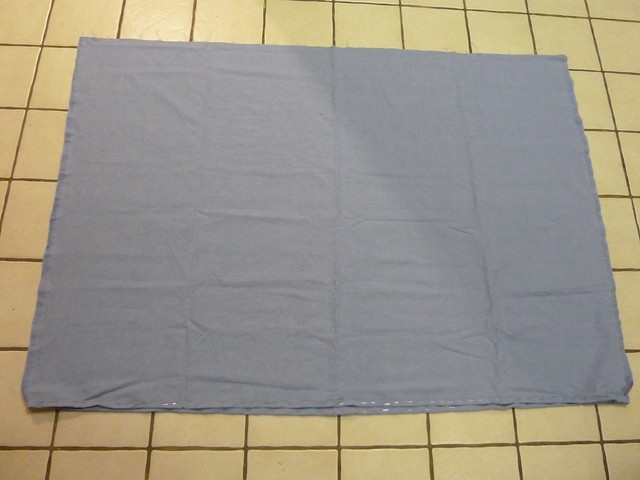
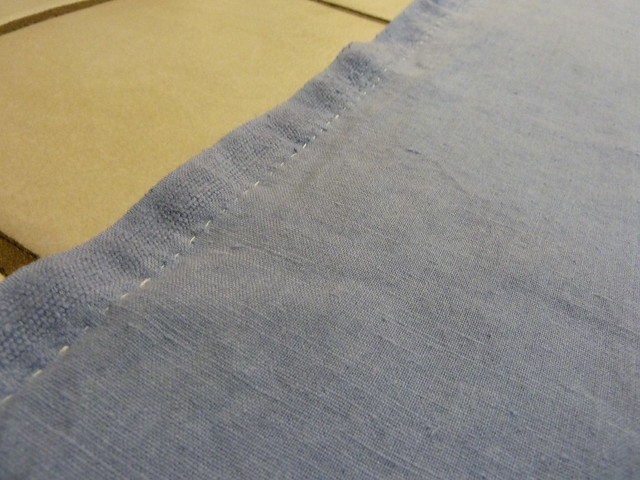
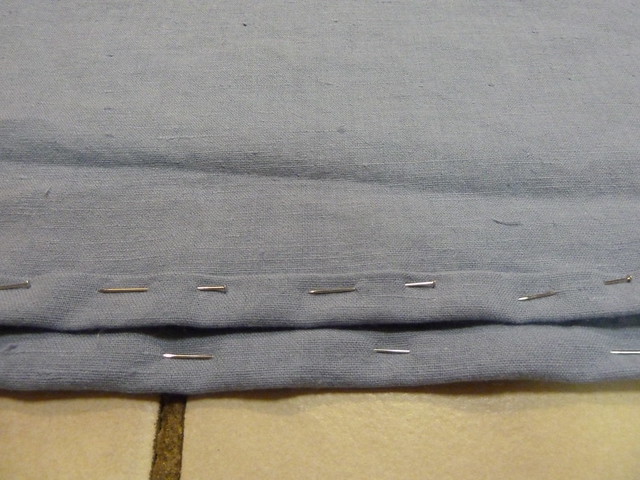
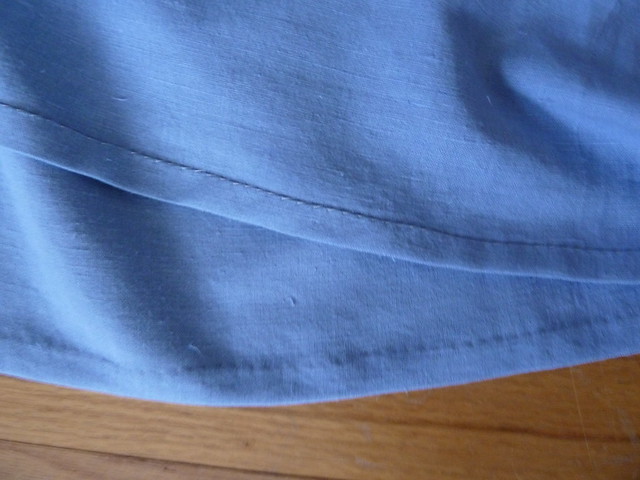

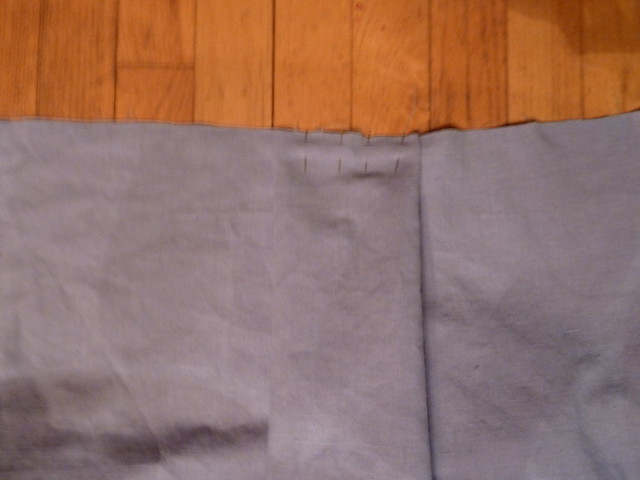
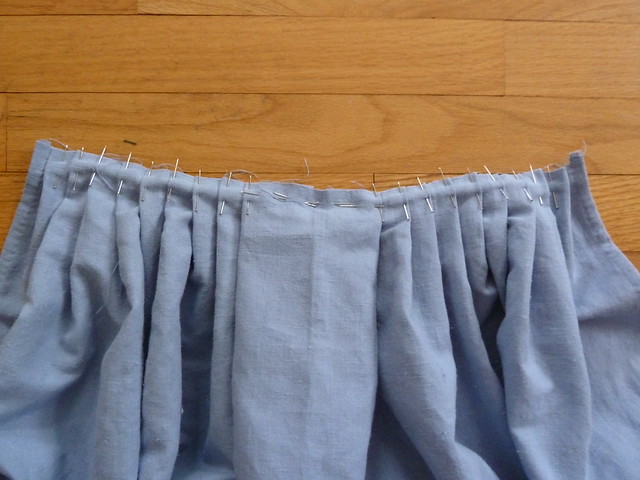
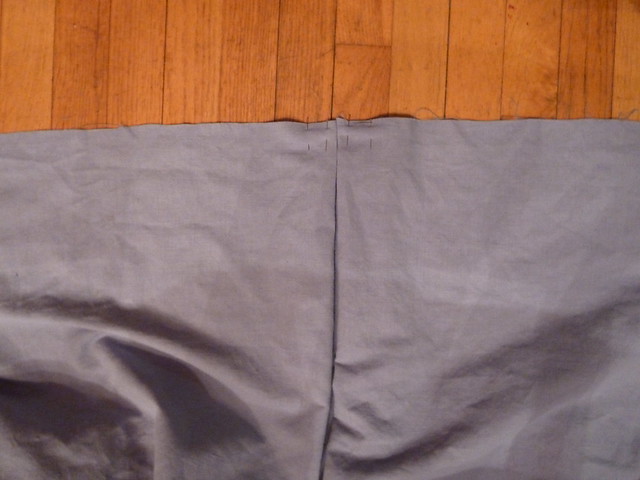
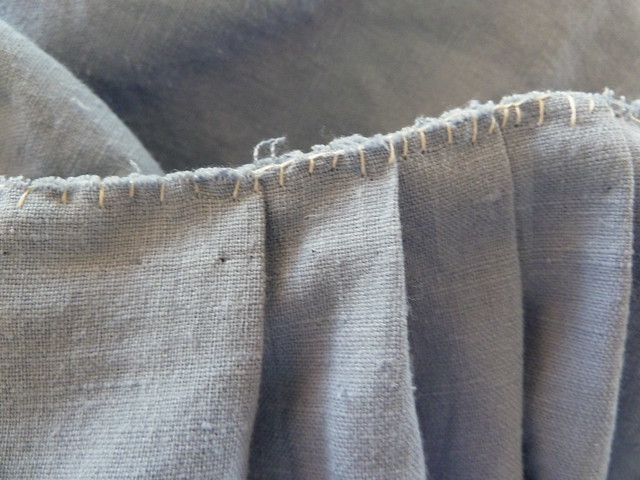
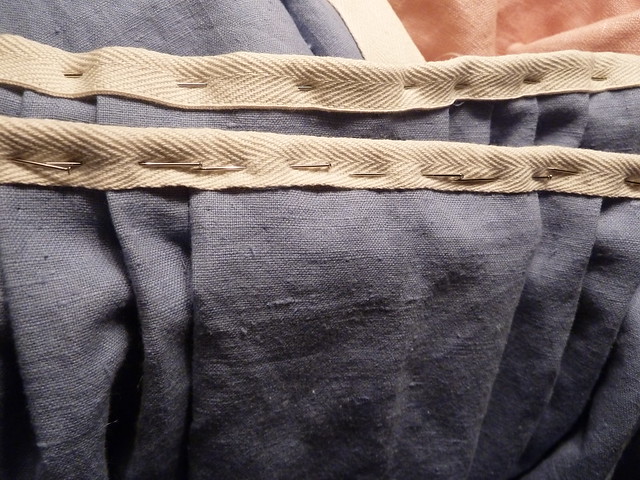
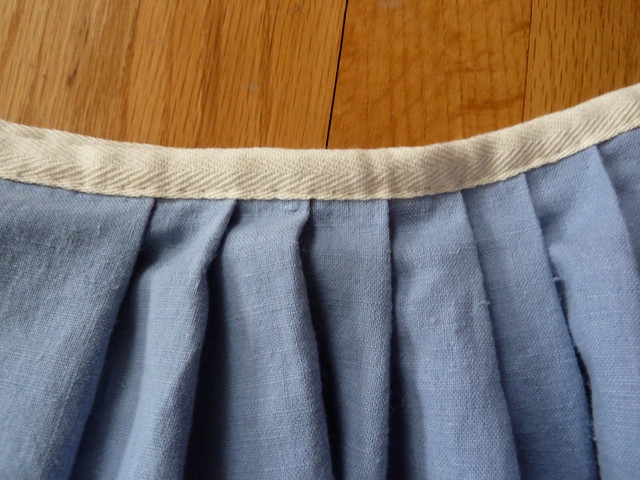
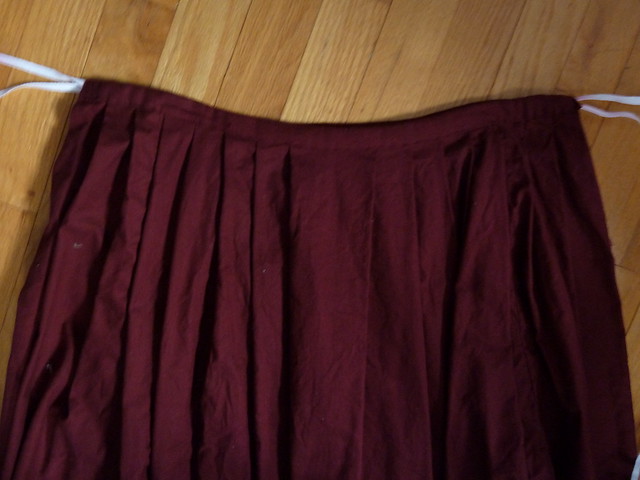
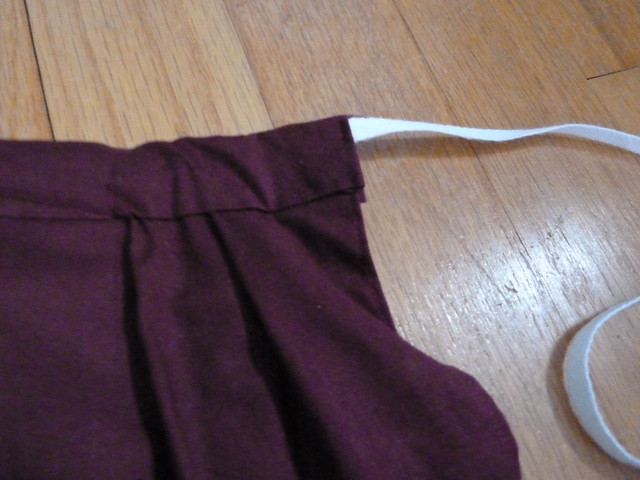
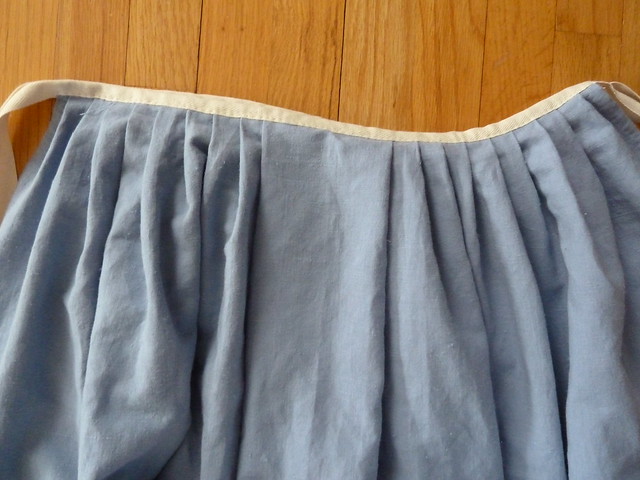

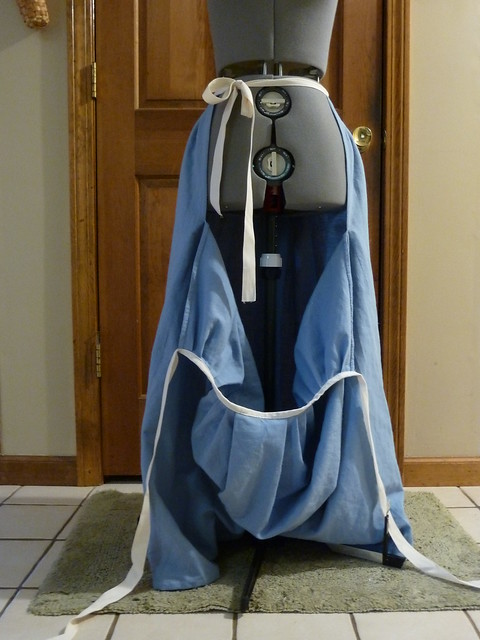
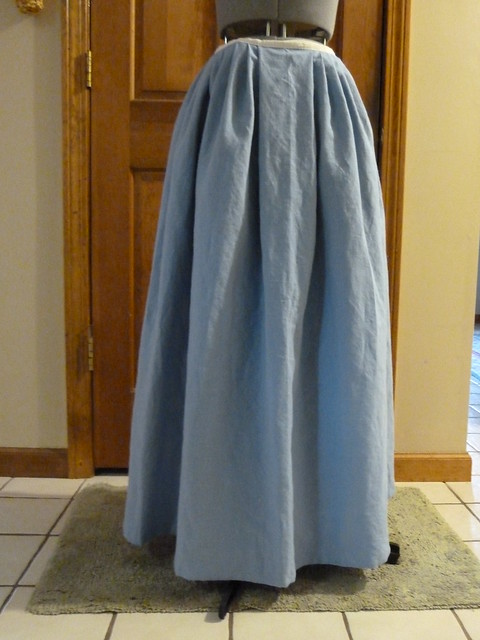
Dear Rebecca,
ReplyDeleteTerrific! This helps a good deal and I am keeping a link to it handy.
While I do 1790s dress, petticoats were still worn, and so far as I know, made the same way.
Very best,
Natalie
Thank you for the details and pictures!
ReplyDeleteLaurie
How wonderful! thank you so much!
ReplyDeleteAwesome tutorial - thanks! Much easier to understand than plain text instructions!
ReplyDeleteOne thing to consider adding - finishing the hem with a scrap of printed cotton like the petticoat in Fitting and Proper. It makes for a cute flash of pattern in an underpetticoat.
I'm so chuffed to know this has proven useful to you all! :-)
ReplyDeleteJulie, thanks for that addition and the reference to F&P! I elected not to include it here mostly because I was trying to keep things as simple as possible in this particular example and didn't want to venture into the petticoat vs. underpetticoat issue. But I totally agree - a strip of printed fabric is always a unique way to "dress" up a plain underpetticoat. Even if it's only ever seen by you alone, it's that much more fun to know it's there! :-)
I used this for 2 cotton petticoats and recently 1 quilted petticoat. Works like a charm and they always end up looking so good! Thanks for posting these instructions!
ReplyDelete"Anonymous," so glad to hear you enjoyed the tutorial! It's nice to know it's still in use, more than a year after posting it! Knowing this, we'll definitely be more diligent about trying to offer more tutorials in the future!
ReplyDeleteI just used your tutorial, and I am so pleased that I did! Thank you!!! My petticoat is amazing!
ReplyDeleteHave just started sewing again after 40 odd years, & hope to make this item soon. It will hopefully be ok for our Regency era of 1805
ReplyDelete(UK ).Thanks so much.
Great tutorial. I hope It will work for my 1790's ensemble. Will post a link when I make it. :)
ReplyDeleteI've just finished my petticoat using your tutorial
ReplyDeletehttp://stitchintimeandspace.blogspot.co.uk/2014/03/hsf-2014-challenge-4-under-it-all-18th.html
Lady D, your petticoat came out beautifully! Thanks for sharing your link. And I love the color you chose, too! :-)
ReplyDeleteHi Rebecca,
ReplyDeleteI've come across a term, probably 18th century that describes a petticoat as 'ruffety' or some similar word. Any ideas what the original word might have been or what it means please?
Hi Steve!
ReplyDeleteThe only reference I can think of off the top of my head to the term "ruffety" is in the context of a folk song. Where did you happen to discover the word? My reponse might change depending on the contextual use.
But without knowing more about how specifically it's being used, I'm assuming that the word is drawing on its old English context - "ruffed" meaning "disordered" or "disheveled," which makes sense in the context of the song I'm thinking of. I can't recall ever seeing it used in a fashion context, but if anyone else has, please chime in and let us know!
The only other possibility I can think of is that it simply means "ruffled."
Hope this helps a little! If you can find the context, I'd be interest in seeing how specifically the word is being used.
Hi, I just wondered if you could use this method for petticoats worn over a bum/hip roll? Or how it could be adapted to make a petticoat like that? Complete Newbie to costuming really but I want to try and make a jacket-and-skirt ensemble!
ReplyDeleteHello! The basic construction details are the same for a petticoat meant to be worn over skirt supports. Because the hem needs to be straight at the bottom, however, the extra length needed to accommodate the bum roll has to be worked in at the waistline.
ReplyDeleteThe easiest way to do this is to cut your panels maybe 2.5-3" longer than the "natural" length. Pleat them as described in this tutorial, but don't sew the pleats - just leave them pinned. Then put on your bum roll and put "on" the petticoat and tie your waistband ties around the top of the petticoat so that they hold up the tube of fabric. Have someone else check the length of the petticoat. Even out the hem and adjust the length by pulling/letting out fabric at the wasitline. When you're satisfied, have your helper pin the waistband tapes into place and then take it all off and finish the waistband according to the remainder of the tutorial!
I hope this helps! It's kind of hard to describe without illustrations! :-)
Hello Rebecca !
ReplyDeleteI've used your tutorial to make a grey petticoat (that I love) and I was wondering if I could reproduce it and translate it (my blog is in both english and French) and citing you of course. I'd be absolutely glad to make this tutorial available to a French community who is not always great at English.
In any case you can see the petticoat - and the blog by the same occasion ;) - at the following address : http://lemondedemacouture.blogspot.fr/2015/11/jupon-gris-pour-la-robe-xviiieme-grey.html
If you also happen to have feedback/opinion about my blog, I'd be glad to hear from you :D
Best,
Cuillère
Would LOVE to see a video of this!!
ReplyDeleteHands down, this is the best 18th century petticoat tutorial out there! Thank you so much for sharing such a fantastic resource!!
ReplyDeleteIn fact, I used your tutorial to make a chocolate linen petticoat for my 1830s working class ensemble here: http://youngsewphisticate.blogspot.com/2015/12/short-gown-study-iii.html. (Photo shoot here: http://youngsewphisticate.blogspot.com/2015/11/ode-to-autumn-1830s-photo-shoot.html) And, I hope you don't mind me sharing your link!
Thanks again & keep inspiring us, Anneliese :)
I really needed your tutorial today. I have made several drawsting that just are not quite right, this will be my first attempt with the pleats. Your suggested measures are very helpful. Thank You
ReplyDeleteI've been looking for info on colonial aprons and specifically linen tape for the ties. Your construction details are the closest I've found and I plan to weave the tape myself, so 1" it is. Thank you!
ReplyDeleteDid you make the tutorial for a petticoat over a skirt support like a bum pad?
ReplyDeleteThis is fantastic, thank you for posting. I spent ages online looking for some advice and guidance on how to make a late 18th century petticoat and was very glad to find your page. Now I'm off to make this in some red wool :-)
ReplyDeleteDid you ever do the tutorial for a shaped petticoat? I have made one that goes over pocket hoops, but now am working on one that goes over a bum roll and I'm confused how much of the front upper edge I need to "scoop" out so that the hem is level all around. I tried making the panels straight and leveling the hem but it was SO hard!
ReplyDeleteI have been using a pattern for dolls and it just was very hard to understand but with this I know what I am doing wrong thanks
ReplyDeleteReally i appreciate the effort you made to share the knowledge.The topic here i found was really effective to the topic which i was researching for a long timepinecrest tutoring
ReplyDeleteThank you for posting this.Private tutor Highland Beach You most absolutely have built this blog website into something special.
ReplyDeleteA mind blowing article is provided here. SAT Tutor Gulf Stream And it is written with great skill and the words directly explain the thought of author.
ReplyDeleteIt is awesome list.I wasn't aware of this feature of this article.Jupiter Island Tutoring thanks!
ReplyDeleteThis is a very useful post, I was looking for this info.Boca Raton Tutoring thanks for sharing the great ideas...
ReplyDeleteIt was a beneficial workout for me to go through your webpage. Private tutor Westport It definitely stretches the limits with the mind when you go through very good info and make an effort to interpret it properly. I am going to glance up this web site usually on my PC. Thanks for sharing
ReplyDeleteThis is very nice blog because information provided here through the article and the pictures are very effective. Private tutor Greenwich Because sometimes words cannot explain the things that pictures can and here the words and pictures both are expressing the things in balance.
ReplyDeleteI’ve desired to post about something similar to this on one of my blogs and this has given me an idea. Private tutor Sag Harbor Cool Mat.
ReplyDeleteThanks a lot for this tutorial, I was looking everywhere for clear instructions of how to make this petticoat for my reproduction doll, this is the best and easiest to follow. :)
ReplyDeletePost is interesting. I appreciate you publishing because I have been curious about this matter. Post is quite nice. It's a really lovely and helpful post. Thanks. View this article for more information Fix Fortnite FPS Drops. If you play Fortnite and experience FPS drops, this post will show you how to resolve the problem.
ReplyDeleteGet straight tuck end boxesat best price with free design. We provide free shipping all over the world.
ReplyDeleteIf you're looking for high-quality clothes at affordable prices then New York's Soho is definitely worth checking out!
ReplyDeleteembroidered polo shirts